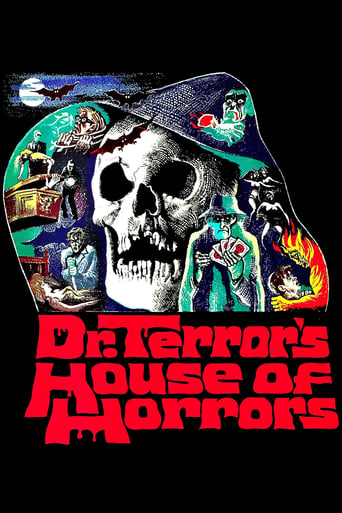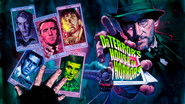dobbiesautographs
yet another excellent British horror movie from the 1960's . I was pleasantly surprised with the special effects from such an old movie , each segment had it's own brand of humour and horror , perfectly combined . and if it wasn't for the fact they all died , that would have made for a fantastic train ride , with so much talent in one place . I recently watched this movie again , on horror channel , & in my opinion it has not lost any of it's charm , and is still very watchable today - a true testament to the actors , writer , and director . it is very skilfully filmed , written , and acted . a true must have for all collectors of horror classics .
Prichards12345
The first Amicus anthology movie was a sizeable hit on release, and was also liked by the critics. And it's not hard to see why. Inspite of the corny endings provided by Milton Subotsky to many of the tales here the whole thing has a rather endearing whiff of UK pop culture, and an off-beat approach to casting that has caused it to be much loved. Who said corn is always bad? Subotsky, of course, dusted off some scripts he'd had knocking around since the late 1940s, and he doesn't seem to have updated them much. But the film itself overcomes its low budget and story shortcomings to retain its appeal. Subotsky was a very child-like man in many ways, an absolute devotee of horror movies who favoured quirky endings rather than gore. I always think of him as a sort of low-rent Val Lewton, which is probably unfair.On to the tales then, which have as a framing device Peter Cushing as a heavily-eyebrowed and thickly-accented Tarot card reader, predicting the future for five passengers sharing his train carriage. Cushing is a quite wonderful Doctor Shreck, all suggestive glances and mild demeanor.And the cast is hilarious to British viewers. Cushing and Lee! "Fluff" Freeman! Roy Castle! The Goughster! Donald Sutherland! And Ursula HOWELLS playing a werewolf! You couldn't make it up.Said werewolf is the first story and is a decent opener, with Neil Mccallum's architect finding out it's not all plain sailing when a rich widow needs some work doing to her house on a remote Scottish Island. Cosmo Valdemar, the original werewolf, sounds like a cross between Poe and Les Dawson! The second tale is legendary for its hilarious naffness; in which Fluff and family are menaced by a killer mutant plant. A plant with a self defence mechanism I can buy. But one that deliberately cuts the phone lines??? Fluff presumably gets strangled, but the ending appears to have been cut out of this one, presumably because it was even sillier than what has gone before. The kid being upset over the dog, though, is a wonderful moment in an otherwise fantastically stupid and entertaining segment.Third tale up has Roy Castle stealing voodoo music from Dhamballa and paying the penalty. Better than listening to Kenny Lynch, I suppose. It has an enjoyable "Lewton Bus" and a nicely low budget version of the West Indies. Castle is very likable as a typical British guy abroad (in those days, anyways).Fourth and best story concerns Christopher Lee's arrogant art critic getting his comeuppance at the hand (literally) of Michael Gough. The story is called "Crawling Hand" funnily enough. Great gag with the chimp, and Lee shows a side of himself not seen much before by UK cinema patrons - flailing about in abject terror when the hand clutches his foot. Very effective and probably the most frightening of the tales here.Cue Sutherland being arguably the thickest medical practitioner in history and being duped into staking his vampire bride. Max Adrian is splendidly scene-stealing as his fellow Doctor. "This town isn't big enough for two doctors....or two vampires." as he makes like Batman and swoops off into the night. Pure corn, but vastly enjoyable.And of course the end of the whole thing - "Have you not guessed?" arguably the most genuinely chilling moment in the movie, perfectly acted by Cushing.Amicus sort of cornered the market on anthologies after this; but no, they did NOT make that movie where Joan Collins gets cuckolded by a tree...
AaronCapenBanner
Freddie Francis directed this five-part horror anthology framed by five strangers in a train car being read their futures by a mysterious fortune teller(played by Peter Cushing) via Tarot cards. Stories are: 'Werewolf' - Architect discovers a werewolf curse on a job. 'Creeping Vine' - Plants seem to have come to life with murder in mind. 'Voodoo' - A musician steals forbidden music to his regret. 'Disembodied Hand' - An art critic is pursued by the artist he killed. 'Vampire' - A young doctor discovers his new wife is a vampire. Costars Christopher Lee, Roy Castle, Donald Sutherland, Michael Gough, among others. Framing device of the train car is more effective than the five tales themselves. Marginal film does have an effective ending.
fedor8
On paper, DTHOH would appear to be a trite collection of clichéd tales straight out of a cmoic-book, and this would have been the case were it not for the good cast and the fact that it was filmed in the 60s. All the lamest horror-film clichés dominate the 5 stories: werewolves, voodoo, killer plants, a crawling hand and vampires. "Werewolf", the first story, is a straight-forward tale with a solid end-twist, though not too eventful in the meantime."Creeping Vine" is, well, about a creeping vine, what else? A standard but fun killer-plant story. It includes a brief lecture on the different types of plant-life. Just for the record, here they are: 1) plants without roots, stems or leaves, such as bacteria, 2) mosses, 3) ferns, 4) flowering plants, and 5) insectivorous plants. DTHOH was made in the 60s so back then they weren't aware of the existence of a 6th plant type, and that is the "sean pennia". It is widely regarded now as the most primitive form of all plant types, hence it's safe to say that it wasn't advanced enough to commit the killings perpetrated in this story."Voodoo" is the weakest story, quite forgettable, about a dim-witted, always grinning musician. It's full of annoying loud jazz music that will have you rooting for his death in no time. Besides which, voodoo is the most tiresome cliché of all five covered here."Disembodied Hand" is a fun one, thanks to Lee who plays arrogant, pompous characters so well. His distaste for Cushing and his tarot cards during the between-stories bits was fun too. Btw, that clever monkey-drew-the-paintings shtick had later been used to great effect by a German hidden-camera TV crew in the 80s. What better way to crush the pretentious idiocy of the art-world than by sticking a brush into a monkey's hand? It works every single time."Vampire", with Donald Sutherland looking as goofy as he always does, has a nice end-twist at the end that gives it an excuse to be in the movie. Solid.Naturally, the surprise end-twist of everyone having been killed in the train crash wasn't that surprising. But it matters not. Half the episodes of "The Twilight Zone" were predictable and yet they were fun. It's the atmosphere that counts, and this 60s flick has that to a reasonable extent.For similar anthologies but better quality, check out "Vault of Horror" (better, more original stories) and "The House That Dripped Blood" (visually impressive).










